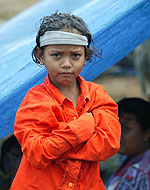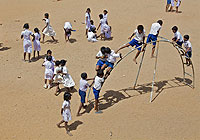
Five years ago the world watched in horror as nearly 230,000 people, particularly women and children, perished in the tsunami that struck south Asia. The powerful force washed away homes, schools and devastated communities, many of which were impoverished and in remote areas. So many families not only had to cope with the loss of loved ones, but also the task of rebuilding after their lives were literally wiped away in just a few moments.
In the years since, UNICEF and its partners have worked to ease the pain, rebuild and bring improved social services, clean water, and sturdier schools to the region.
To give children a much-needed head-start in life, we have helped build nearly 100 health centers, equipped more than 7,000 health facilities, and trained 60,000 healthcare workers.UNICEF has also supported campaigns for mass vaccination, mosquito net distribution and nutritional monitoring. All of these efforts are critical in containing the spread of disease and keeping residents healthy.
 Education helps bring children together with other students, providing an important structure for support, learning and a sense of normalcy back to their lives. This was a top priority in the aftermath and today more than 300,000 students learn in new or repaired schools. And, over 1.3 million children have benefited from psychosocial activities to help them cope with the trauma of the tsunami. In addition, more than 30,000 educators have been trained in child-friendly approaches.
Education helps bring children together with other students, providing an important structure for support, learning and a sense of normalcy back to their lives. This was a top priority in the aftermath and today more than 300,000 students learn in new or repaired schools. And, over 1.3 million children have benefited from psychosocial activities to help them cope with the trauma of the tsunami. In addition, more than 30,000 educators have been trained in child-friendly approaches.
Schools have also seen improvements in clean water and sanitation. Clean water has come to communities thanks to new wells, new toilets and new waterworks. Over 820,000 people across the region have benefitted from restored water points.
Programs such as these, developed during the tsunami response, are not only aiding the affected countries but also helping respond to other humanitarian situations around the world. For instance, improved emergency procedures have allowed UNICEF and its partners to better deliver relief supplies and protection measures children.
The dedication and hard work of so many partners toward recovery will help ensure that those who were impacted by the devastation have more resources and programs in place to help them recover and have a more hopeful future.
While there is still much work to be done, all the heartfelt support from around the world has helped provide much needed relief and resources to help the region cope and rebuild.
Ann Veneman is the Executive Director of UNICEF. UNICEF just released a report, Tsunami Five Years Later, that marks progress and lessons learned from the relief, recovery and rebuilding efforts. To learn more visit www.unicef.org.